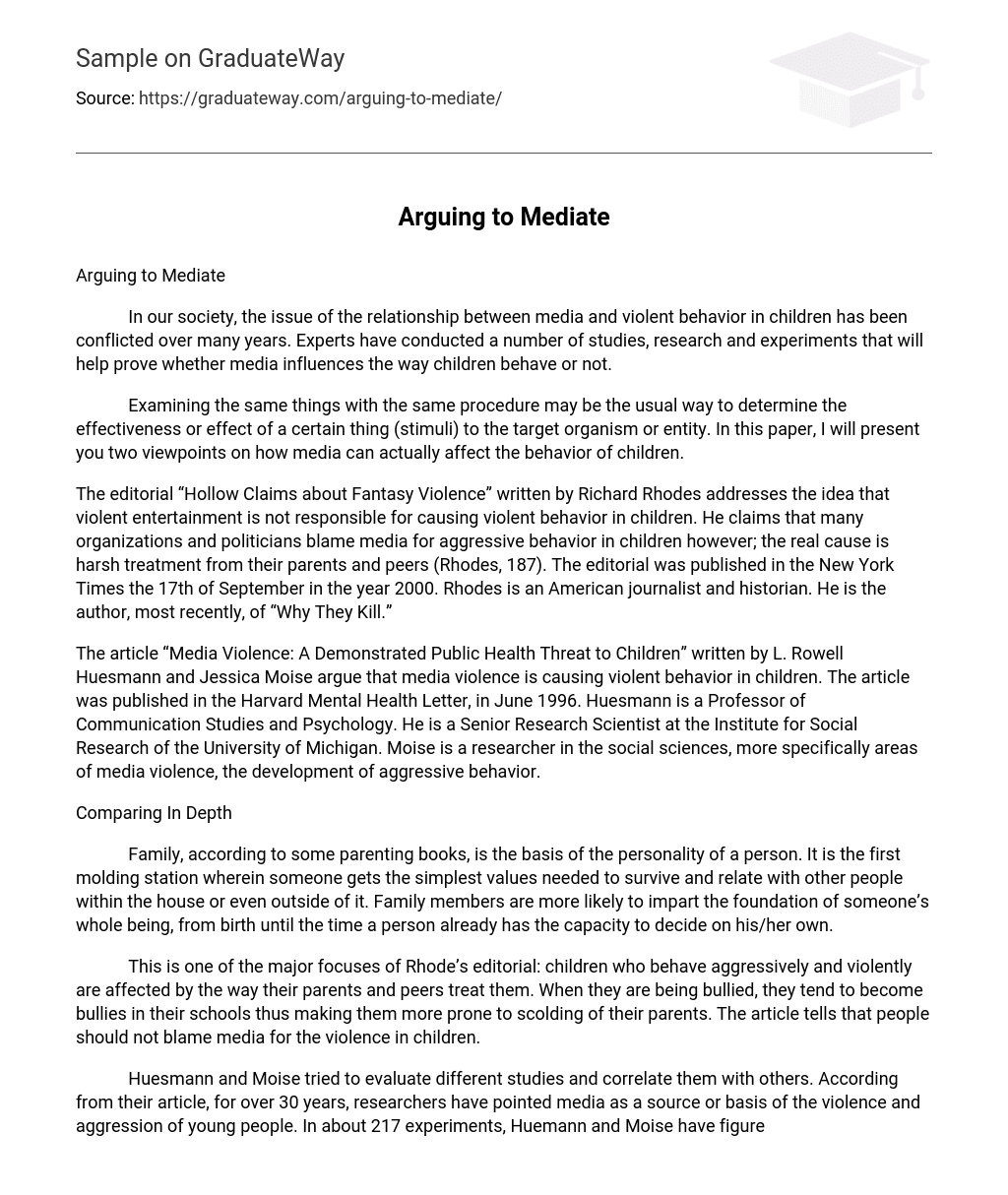In our society, the issue of the relationship between media and violent behavior in children has been conflicted over many years. Experts have conducted a number of studies, research and experiments that will help prove whether media influences the way children behave or not.
Examining the same things with the same procedure may be the usual way to determine the effectiveness or effect of a certain thing (stimuli) to the target organism or entity. In this paper, I will present you two viewpoints on how media can actually affect the behavior of children.
The editorial “Hollow Claims about Fantasy Violence” written by Richard Rhodes addresses the idea that violent entertainment is not responsible for causing violent behavior in children. He claims that many organizations and politicians blame media for aggressive behavior in children however; the real cause is harsh treatment from their parents and peers (Rhodes, 187). The editorial was published in the New York Times the 17th of September in the year 2000. Rhodes is an American journalist and historian. He is the author, most recently, of “Why They Kill.”
The article “Media Violence: A Demonstrated Public Health Threat to Children” written by L. Rowell Huesmann and Jessica Moise argue that media violence is causing violent behavior in children. The article was published in the Harvard Mental Health Letter, in June 1996. Huesmann is a Professor of Communication Studies and Psychology. He is a Senior Research Scientist at the Institute for Social Research of the University of Michigan. Moise is a researcher in the social sciences, more specifically areas of media violence, the development of aggressive behavior.
Comparing In Depth
Family, according to some parenting books, is the basis of the personality of a person. It is the first molding station wherein someone gets the simplest values needed to survive and relate with other people within the house or even outside of it. Family members are more likely to impart the foundation of someone’s whole being, from birth until the time a person already has the capacity to decide on his/her own.
This is one of the major focuses of Rhode’s editorial: children who behave aggressively and violently are affected by the way their parents and peers treat them. When they are being bullied, they tend to become bullies in their schools thus making them more prone to scolding of their parents. The article tells that people should not blame media for the violence in children.
Huesmann and Moise tried to evaluate different studies and correlate them with others. According from their article, for over 30 years, researchers have pointed media as a source or basis of the violence and aggression of young people. In about 217 experiments, Huemann and Moise have figured a strong attachment of violent shows to aggressive behavior of the children.
In line with their assumptions and theories, there are five specific examples to support their claims:
· Children imitate what they see – as for the heroes and the cartoons that portray goodness overcomes evil. Children opt to become aggressive and violent to the people or other children that will cause them harm, as if they are attacking their villains.
· Media violence stimulates aggression by desensitizing children – making children believe that it is somewhat acceptable to act and behave violently, since they are used to seeing it.
· Children watch violent media and justify their own aggression – since they already know that many people blames media for their violence, they are taking this reason to act as violent as they can consciously or unconsciously.
· The observation of aggression results in cognitive priming – just like applying paint to an object with a prime coating then followed by a second coating making the color of the paint brighter.
· Children become physiologically aroused in response to violence – like a rule in economics that provides less satisfaction with consumption over time. (Huesmann and Moise200-201).
Though the two sets of knowledge about children violence provide different sources of the behavior, it is important to note that what matters is that children only imitate what they see. If the child sees his/her parents is comfortable with procuring pain with others, it is inevitable that they will do the same thing. Moreover, if children will see more violent acts in a higher intensity, they are more likely to inhibit them and off course practice them to their playmates or classmates.
Since many literatures already showed how the environment of a child affects hi/her behavior, it is vital that parents or older people device programs or activities that will enhance the inter-relationship of the children thus providing them with values that will be helpful as they grow up; say, communication skills that are important in conveying their ideas and feelings to others. Media is indeed a source of entertainment and education; however, it is still important that certain standards will be implemented with the way they are being exposed to younger people.
List of References
Huesmann, L. Rowell and Moise, Jessica. Media Violence: A Demonstrated Public Health Threat to Children. [12 March 2009]. <http://www.rcgd.isr.umich.edu/aggr/articles/public/1996.MediaViolence.pdf >
Rhodes, Richard. Hollow Claims about Fantasy Violence. [13 March 2009]. <http://query.nytimes.com/gst/fullpage.html?res=9F02EFD81138F934A2575AC0A9669C8B63&n=Top/Reference/Times%20Topics/Organizations/A/American%20Academy%20of%20Pediatrics>





